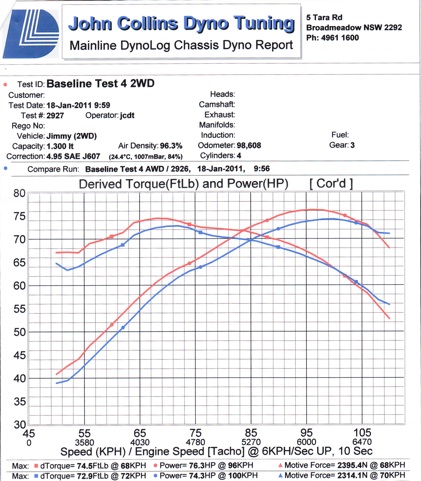Dyno Results
of an M13A-powered Jimny
Suzuki Jimny and Power Output are generally not spoken out loud.
Peak power and torque curves from a Dyno Tune machine can create sideways glances from chest beating large-4WDers.
So why do I have Dyno results?
When looking for extractors for my 2005 model, I was always informed that "no-one makes em".
After 6 years and 100,000km ticking over I decided to find someone willing to spend the time to fabricate a manifold for me. And I was curious of what, if any, power gains I would achieve.
I planned to do the installation in two parts
Step 1. Replace the existing exhaust manifold with new ceramic coated extractors and leave the standard exhaust from the catalytic converter back.
Step 2. Upgrade the exhaust from the catalytic converter back in the same pipe size as the new extractors - see the dyno 2 results here.
Three dyno's: before, during and after will cover the progress (but alas, the car was totalled too soon).
Word of mouth is a great way to network in the automotive industry, but the Yellow Pages also works, where I found a Dyno Tuner an hour's drive away. One phone call had me booked in the following morning.
And so, Fortune found me standing in a workshop with a brand spanking new AWD dyno machine.
Awesome! I could get both 2WD and 4WD Dyno Tune results for just a bit more cash.

Red line - 2WD
Blue line - 4WD
From the 2WD graph, you can see peak power 76.3hp at about 6000rpm and peak torque 74.5FtLb at about 4400rpm.
Comparing these figures to the Technical Data in the owners manual
Max power: 60KW/5500rpm
Max Torque: 110Nm/4500rpm
After doing the si hp conversion: 60KW = 80.45hp.
My jimny is very close to the tuned factory specification. Remember this car has done 100000km.
It's also interesting the marginal difference between 2WD and 4WD power and torque.
From the 4WD graph, you can see peak power 74.3hp at about 6000rpm and peak torque 72.9FtLb at about 4400rpm.
I expected to see more losses through the drivetrain.
